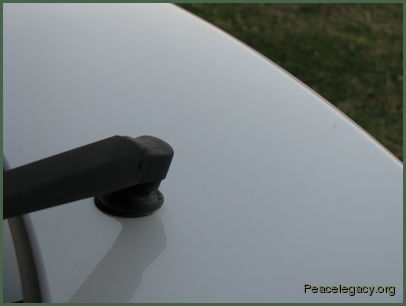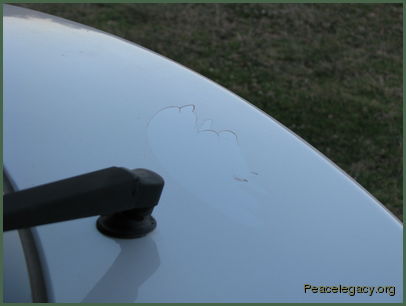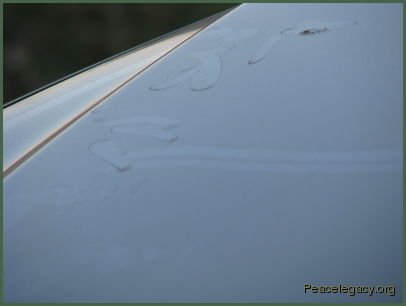The red Australian dust storm: I stood at the window, looking out in amazement. I had never seen anything like this before in my life. The front gate, a mere hundred metres or so away, was close to invisible. The red, choking dust had forced us all indoors, windows shut fast, the dust slowly obscuring more and more of our view. The fine, red silt nevertheless managed to find its way in under the doors and through the smallest crack, coating the floor near the entrances in red. It had blown thousands of kilometres from the red heart of the country, so the particles still in suspension were the finest and lightest, and they went wherever the lightest zephyr could reach. It lasted many days - I am not sure just how long, because, you see, I was only six, and this was more than fifty years ago in the 1950s. You thought I was talking about this week, din'tcha!
And really, the chorus of alarmism that has gone up about the recent two dust storms says more about the mentality of those ranting on than it does about any unusual 'climate change'. For I certainly cannot say that the current storms were the first I have seen - even forgetting the one when I was six, because they come and go every decade or so. They are just not remarkable. Anyone who says otherwise has a shocking case of amnesia or else they have lost the plot entirely.
Let's look at a few examples. This from the ABC:
With climate change a hot topic this week far beyond Australia's shores, experts say extreme dust storms like this could become more frequent.
Dr John Leys from the NSW Department of Environment's Dust Watch division says it looks like dust storms such as this will become more prevalent.
"There has been a report from CSIRO that show that this drought is the first of its type, because we've never had droughts which have been so hot," he said.
"Things like this are going to be more prevalent unless we can improve our land management practices so we can maintain more ground cover, so there is less chance of us all blowing away."
Who are they trying to kid? Here's a few clues for the ABC, from their own article:
A man was rescued from the Simpson Desert near Birdsville in Queensland after his car overturned in the storm. ... Brian Parker from the Construction Forestry, Energy and Mining Union says the windy weather created problems. "With the high winds, it causes a number of problems with the movement of materials [and] cranes operating," he said.
Did you spot it? A drought (dry deserts) and high winds. Those are the only conditions needed to lift particles off the surface and carry them across the continent. And yes, the winds were extremely high - but for the benefit of readers overseas, I'll tell you something else, they were cold, very, very cold. As the storm hit, the sun went dim, and the temperature plummeted. Here's the story from Melbourne's The Age:
Surprise snap puts spring in step of snow lovers
If it felt Antarctic, that’s because it was. The bitterly cold winds that chilled Victoria yesterday had their genesis around the coast of Antarctica three to four days ago, according to the Bureau of Meteorology. ...
The result was Melbourne’s coldest day so far this month, with yesterday’s maximum peaking at just 12.6 degrees. ...
The wintry blast has proven a boon for Victoria’s ski resorts, which were closing down for the season before the weekend brought some of the best falls of the season.
Just days after Mount Buller was reporting virtually no snow, it was last night boasting more than 57 centimetres, with 14 falling yesterday. Overnight, the snow level reached about 1000 metres, with Mt Donna Buang receiving up to 40 centimetres of fresh snow over the weekend.
But ah, I forgot: The hot weather that coincidentally accompanied the high winds over the desert was Climate Change (TM), whereas the cold and the unseasonal snow was merely weather, not to be taken into account and not to distract us from noticing only those weather events that support the alarmist story.
Anyway, let me stop poking fun at the alarmists and make a few serious points.
Firstly, where I live, from about 1998 onwards, the climate has dried out. From the seventies to the mid-nineties, it has also become warmer. Those are observations of plain fact about the Darling Downs region. And the Murray River region is seriously damaged, that's for sure. But why? Here's some remarks from Australia, State of the Environment 2001, published by "Australian State of the Environment Committee, Australia. Environment Australia" and copyrighted by the Australian Government:
Wind erosion has both a natural and human-induced component in most semi-arid and arid regions. In the past 15,000 years Australia has had a wetter climate than during the previous 5,000 years of severe aridity. Dune fields were once vegetated, but in the part 150 years they have been grazed or cleared for agriculture in some regions, and this has contributed to more dust storms than would otherwise occur with today's climates. Dust has been recorded by climatological stations across Australia for many years, but automation is now phasing out reporting of this useful indicator of wind erosion.
The 1996 State of the Environment Report provided dust storm data to show that the annual frequency of dust storms across Australia during the 20th century has notably decreased since the 1970s (SoE 1996, p. 6-30). This was attributed to the improved control of rabbits ... the spread of 'woody weeds' ... and the adoption of conservation tillage. ...
Measurable natural wind erosion occurs over a larger area of the continent than accelerated [human-caused] erosion, and accounts for a larger proportion of total dust lifted into the atmosphere. Seasonal conditions have much to do with this. Figure 17 shows how severe the extent of natural wind erosion can be in droughts (El Niño years).
Let's get this clear: 20,000 to 15,000 years ago (in the ice age) was a period of severe aridity for Australia. But the current interglacial "has had a wetter climate". So cold produced more drought than warmth. More importantly, dust has decreased lately due to better land management. That puts the finger on the real point here. Yes, there is a lot wrong with the environment, and yes, much of it is human-caused. The Murray River disaster is entirely caused by delinquent water and land management over a century. But if everything that is going wrong is always and predictably blamed on "climate change" (dishonest code phrase for an alleged, but certainly nonexistent, ability of plant nutrient to cause dangerous planetary warming) then the real causes won't be noticed and the real actions we could and should be taking to mitigate or remove the damages won't be taken. Make no mistake about it, "climate change" alarmism is extremely dangerous to the health of the planet. That is the true import of the precautionary principle!
Dust storms, as we have seen, are a wind speed and dryness-related phenomenon. But science is neat because anyone can think about things and examine the world around them, even without complicated equipment, and I enjoy just 'poking around' so to speak. So I went outside and photographed my new car. It was picked up the day before the second dust storm, a bright shiny pearl white. And here it is the day after:

It should be pearl white, but as you can see, there is a layer of something on it. Let's disturb it:

When I disturbed the dust, I was quite surprised. 'Local' dust that has been blown up a few kilometres away and settles quickly is kind of - well, dusty, as I am sure you must have noticed. But this dust is so fine (having remained in suspension in the air for thousands of kilometres) that it acts almost like a liquid, even though it is quite dry. It has a certain stickiness about it. Swept onto a dry cloth, it is hard to shake out. This may be some kind of electrostatic effect; whatever, it is surprising how differently it acts from ordinary dust. Here's another photo, showing the strange qualities of this unusual material:

Fascinating! I love pondering this stuff and seeing where the thoughts take me, but back to the point. That dust is settling very slowly! If I am in a representative location, the film on the car is quite thin, after more than a day in the thick dust. The dust settles slowly for the very reason that the dust still in the air is the extremely tiny particles that have not settled close to the sweep-up zone. Yet people seem to be thinking that this dust will somehow choke the coral in the reef. No scientist I can find is saying so, but a lot of lay people are imagining the reef being slowly suffocated in a thick miasmic layer of red. (I've heard it on radio and seen it in lay blog posts.) But particles settle even more slowly in water than they do in air, for the obvious reason that water is so much more dense. True, some will settle on the land and be washed into the ocean through the river system when it next rains. But the dust in water, however it gets there, will settle out hundreds of times more slowly than it settles from air. It wouldn't surprise me if it went many times around the planet with the ocean currents before finally settling, spread out all over the ocean floors of the world. The Barrier Reef just is not going to get plastered in dust in the way that has been portrayed.
The point is, it is so very easy to get unwary people swept up in alarmism. Wait for some striking happening, blame it on global warming, stir up the emotions, and give the climate realists the uphill job of calming the agitated masses down again. And even if they do that, then say "Ah, yes, but be worried anyway because of the 'precautionary principle'." Causing mischief is much easier than fixing it, so this battle will always be slanted in favour of the hoaxsters.



Re: Those evil, global warming-caused dust storms!
The voice of reason is sweet.
'Causing mischief is much easier than fixing it'. Well put.
The lack of principle in the alarmist is a worry.